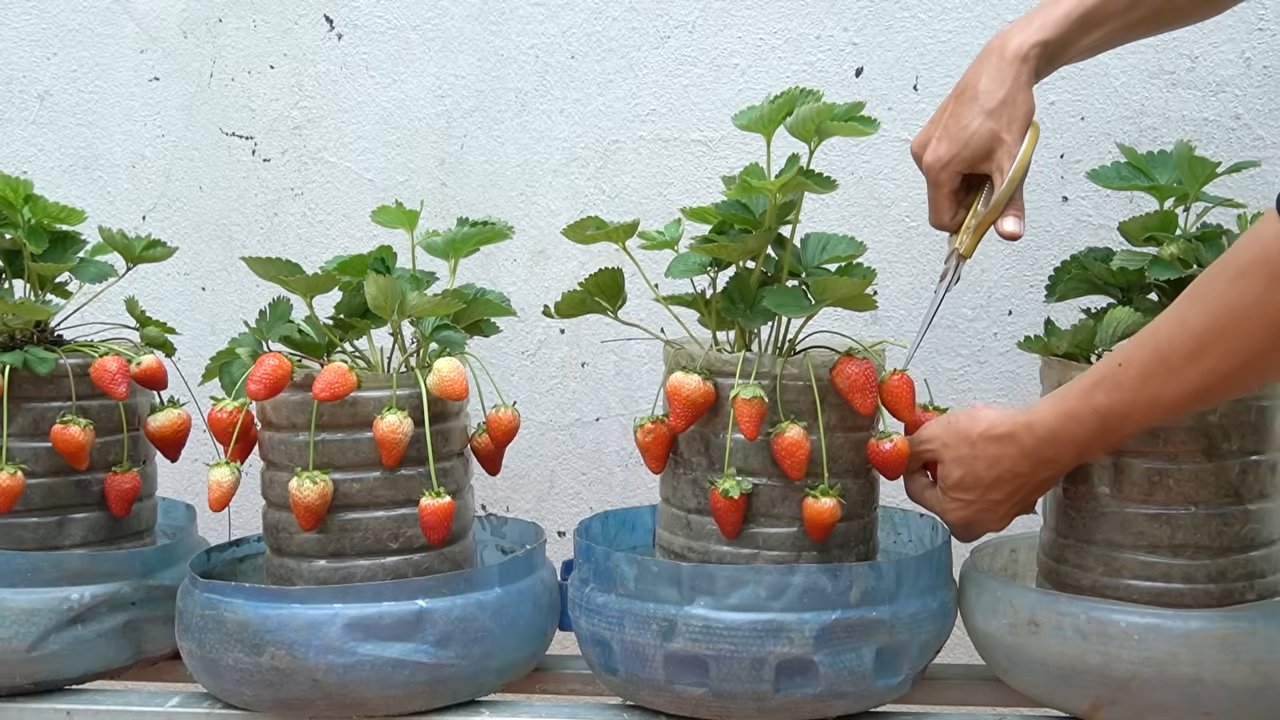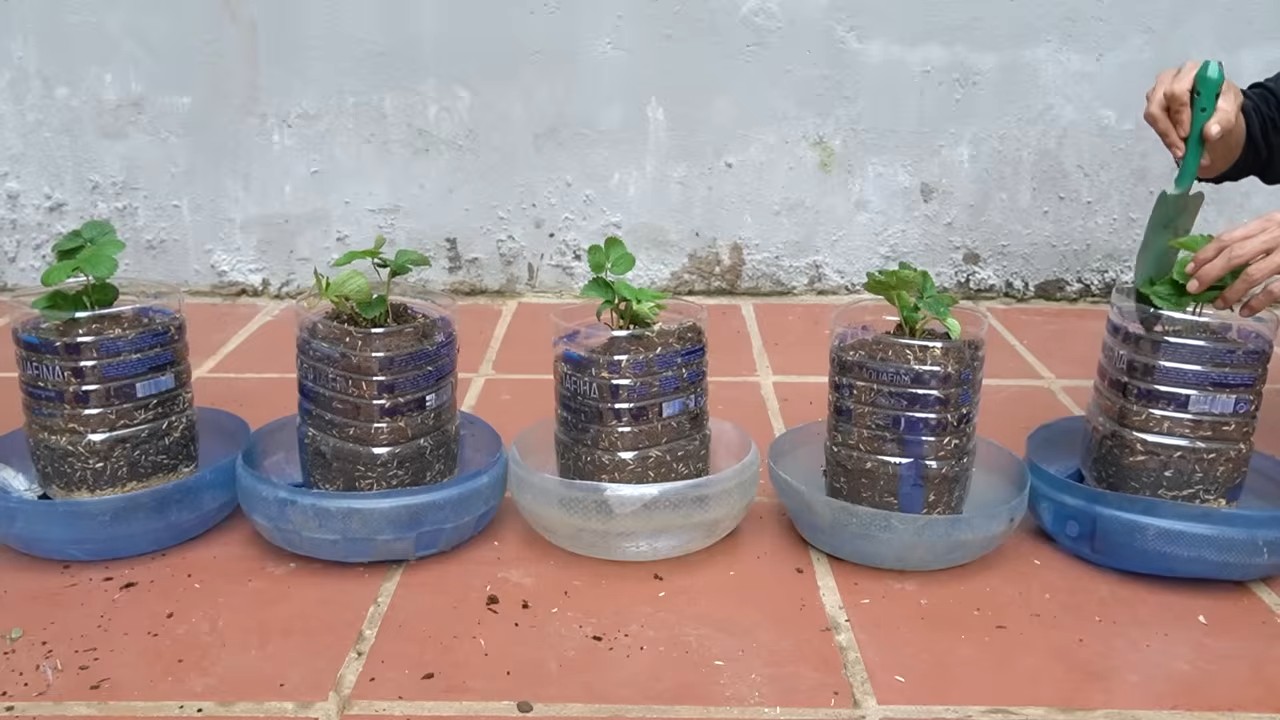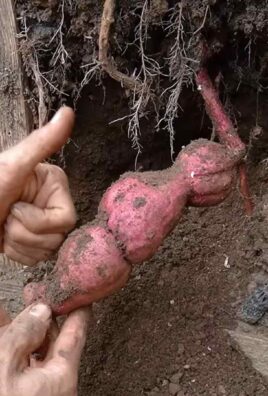Wild Strawberry Monthly Harvest: Imagine stepping into your backyard and, month after month, being greeted by the sweet, tangy aroma of freshly ripened wild strawberries. Sounds like a dream, right? Well, it doesn’t have to be! I’m here to share some amazing DIY tricks and hacks that will help you achieve a consistent wild strawberry monthly harvest, turning your garden into a delicious, fruitful paradise.
For centuries, wild strawberries have held a special place in our hearts and cultures. From ancient Roman feasts to Native American traditions, these tiny berries have been cherished for their unique flavor and medicinal properties. But let’s be honest, relying on finding them in the wild can be a hit-or-miss affair. That’s where these DIY tips come in!
Let’s face it, who wouldn’t want a steady supply of these delightful treats? Store-bought strawberries just don’t compare to the intense flavor of wild ones. Plus, growing your own is incredibly rewarding and a fantastic way to connect with nature. This article will provide you with simple, effective strategies to extend your wild strawberry monthly harvest, ensuring you have a continuous supply of these little gems throughout the growing season. Get ready to roll up your sleeves and transform your garden into a wild strawberry haven!

DIY Wild Strawberry Propagation for a Bountiful Monthly Harvest
Okay, strawberry lovers, let’s talk about getting more of those delicious wild strawberries! I’m going to walk you through a simple, yet effective, DIY propagation method that will have you harvesting these tiny treasures practically every month. We’re going to focus on runner propagation, which is the easiest and most natural way to multiply your existing plants. Get ready to expand your strawberry patch!
Understanding Wild Strawberry Runners
Before we dive in, let’s quickly understand what runners are. Wild strawberries, like many strawberry varieties, send out long, horizontal stems called runners (or stolons). These runners are basically extensions of the mother plant, and they’re designed to create new baby strawberry plants. At various points along the runner, you’ll see little nodes that will develop into roots and leaves, forming a brand new plantlet. This is what we’re going to harness to create our monthly harvest!
Materials You’ll Need
* Healthy wild strawberry plants (the mother plants)
* Small pots (3-4 inch diameter are perfect)
* Potting mix (a well-draining mix is crucial)
* Watering can or hose with a gentle spray nozzle
* Scissors or pruning shears
* Optional: Rooting hormone (this can speed up the process, but isn’t essential)
* Optional: Landscape fabric or mulch
Propagation Step-by-Step Guide
Here’s the breakdown of how we’re going to propagate those wild strawberries:
* Step 1: Preparing the Pots
* Fill each pot with your well-draining potting mix. Make sure the soil is loose and not compacted.
* Water the soil in the pots thoroughly until water drains out the bottom. This ensures the soil is evenly moist before we plant.
* Step 2: Locating and Selecting Runners
* Carefully examine your existing strawberry plants. Look for healthy runners that have already started to develop small plantlets (baby plants) with tiny leaves.
* Choose runners with well-formed plantlets. The bigger and healthier the plantlet, the better the chances of successful propagation.
* Step 3: Positioning the Plantlets
* Gently place a pot near the mother plant, positioning it so that the plantlet on the runner sits directly on top of the soil in the pot.
* Important: Do NOT detach the runner from the mother plant yet! The plantlet still needs the mother plant for nutrients and water.
* Step 4: Securing the Plantlets
* Using your fingers, make a small indentation in the soil of the pot.
* Gently press the plantlet into the soil, ensuring the roots (if any have already formed) are in contact with the soil.
* You can use a small U-shaped piece of wire or a plant clip to secure the plantlet in place. This will prevent it from being dislodged.
* Step 5: Optional: Rooting Hormone
* If you’re using rooting hormone, dip the base of the plantlet (where the roots will emerge) into the hormone powder before placing it in the pot. This will encourage faster root development.
* Step 6: Watering and Care
* Water the plantlet in the pot gently, being careful not to disturb the soil.
* Keep the soil consistently moist, but not waterlogged. Check the soil moisture daily and water as needed.
* Step 7: Waiting for Root Development
* This is the patience part! It usually takes about 2-4 weeks for the plantlet to develop a strong root system.
* You can gently tug on the plantlet to check for resistance. If it feels firmly rooted in the pot, it’s ready to be separated.
* Step 8: Separating the Plantlet
* Once the plantlet has established roots, use your scissors or pruning shears to carefully cut the runner connecting the plantlet to the mother plant.
* Cut as close to the mother plant as possible.
* Step 9: Transplanting (if desired)
* You can now leave the new strawberry plant in the pot, or you can transplant it into a larger pot or directly into your garden.
* If transplanting, choose a sunny location with well-draining soil.
* Dig a hole slightly larger than the root ball of the plant.
* Gently remove the plant from the pot and place it in the hole.
* Backfill the hole with soil and water thoroughly.
* Step 10: Ongoing Care
* Water your new strawberry plants regularly, especially during dry periods.
* Fertilize them with a balanced fertilizer according to the package instructions.
* Remove any dead or yellowing leaves.
* Protect your plants from pests and diseases.
Creating a Monthly Harvest Strategy
Now, let’s get to the good part – how to use this propagation method to achieve a monthly harvest! The key is staggered propagation.
* Start Early Spring: Begin propagating runners as soon as you see them appearing in early spring. This will give you a head start on the growing season.
* Continuous Propagation: Don’t just propagate once! Continue to propagate runners throughout the spring and summer. This will ensure a continuous supply of new plants that will produce fruit at different times.
* Succession Planting: As you propagate new plants, keep track of when they were planted. This will help you predict when they will start producing fruit. Strawberries typically produce fruit about 4-6 weeks after flowering.
* Strategic Placement: When transplanting your new strawberry plants, consider their location. Planting them in different areas of your garden with varying sun exposure can also help to stagger the harvest. Some areas might warm up faster, leading to earlier fruiting.
* Variety Selection (Optional): If you’re really serious about a monthly harvest, consider planting different varieties of wild strawberries that have different fruiting times. This will extend your harvest season even further.
Troubleshooting Tips
* Plantlets Not Rooting: If your plantlets aren’t rooting, make sure the soil is consistently moist and that they are getting enough sunlight. You can also try using rooting hormone to speed up the process.
* Runners Drying Out: If the runners are drying out before the plantlets can root, try misting them with water regularly. You can also place a clear plastic bag over the plantlet to create a humid environment. Just make sure to remove the bag periodically to prevent mold growth.
* Pests and Diseases: Keep an eye out for pests and diseases, such as aphids, slugs, and powdery mildew. Treat any problems promptly to prevent them from spreading.
* Poor Soil: Wild strawberries prefer well-draining soil that is rich in organic matter. If your soil is poor, amend it with compost or other organic materials before planting.
Extra Tips for Success
* Choose Healthy Mother Plants: The health of the mother plant directly affects the health of the plantlets. Select strong, vigorous plants for propagation.
* Don’t Overwater: While strawberries need consistent moisture, overwatering can lead to root rot. Make sure the soil is well-draining and avoid letting the plants sit in standing water.
* Provide Adequate Sunlight: Wild strawberries need at least 6 hours of sunlight per day to produce fruit. Choose a sunny location for your plants.
* Mulch Your Plants: Mulching around your strawberry plants helps to retain moisture, suppress weeds, and keep the berries clean. Use organic mulches such as straw, wood chips, or shredded leaves.
* Protect from Birds: Birds love strawberries just as much as we do! Protect your plants with netting or other bird deterrents.
* Winter Protection: In colder climates, protect your strawberry plants from frost and freezing temperatures by covering them with straw or a blanket.
Harvesting Your Wild Strawberries
* Pick Ripe Berries: Harvest your wild strawberries when they are fully ripe and a deep red color. They should be easy to pull from the plant.
* Handle with Care: Wild strawberries are delicate, so handle them with care to avoid bruising.
* Harvest Regularly: Harvest your strawberries regularly to encourage continued production.
* Enjoy Fresh: Wild strawberries are best enjoyed fresh, but you can also use them in jams, jellies, and desserts.
Why This Method Works
This runner propagation method is so effective because it mimics the natural way wild strawberries reproduce. By allowing the plantlets to root while still attached to the mother plant, we provide them with a constant supply of nutrients and water, which increases their chances of survival. The staggered propagation approach ensures a continuous supply of new plants, leading to a more consistent and extended harvest.
Beyond the Basics: Advanced Techniques
If you want to take your wild strawberry propagation to the next level, here are a few advanced techniques to consider:
*

Conclusion
So, there you have it! Mastering the art of a Wild Strawberry Monthly Harvest isn’t just about gathering berries; it’s about cultivating a connection with nature, enjoying the fruits (literally!) of your labor, and ensuring a continuous supply of these delightful treats throughout the growing season. This DIY trick is a must-try for any gardener, from the seasoned pro to the enthusiastic beginner, for several compelling reasons.
Firstly, it maximizes your yield. By strategically harvesting your wild strawberries on a monthly basis, you encourage the plants to produce more flowers and, consequently, more berries. This prevents the plants from focusing solely on seed production and redirects their energy towards creating a continuous stream of deliciousness. Imagine having a steady supply of fresh, intensely flavored wild strawberries to add to your morning yogurt, bake into miniature tarts, or simply enjoy straight from the garden.
Secondly, it promotes plant health. Regular harvesting prevents overcrowding and allows for better air circulation around the plants, reducing the risk of fungal diseases and other common strawberry ailments. Think of it as giving your wild strawberry patch a regular “haircut,” keeping it healthy and vibrant.
Thirdly, it’s incredibly rewarding. There’s something deeply satisfying about nurturing a plant and reaping the rewards of your efforts. The act of carefully selecting and harvesting ripe wild strawberries is a mindful and grounding experience, a welcome respite from the hustle and bustle of daily life.
But the beauty of this DIY trick lies in its adaptability. Feel free to experiment with different harvesting techniques. Some gardeners prefer to use small scissors or clippers to avoid damaging the delicate stems, while others find that a gentle twist is sufficient. You can also adjust the harvesting frequency based on your local climate and the specific needs of your wild strawberry plants. If you notice that your plants are producing fewer berries, try adding a layer of compost or organic fertilizer to boost their growth.
Consider these variations to enhance your Wild Strawberry Monthly Harvest:
* **Succession Planting:** Plant multiple varieties of wild strawberries with different ripening times to extend your harvest season even further.
* **Companion Planting:** Plant herbs like basil or thyme near your wild strawberries to deter pests and improve their flavor.
* **Vertical Gardening:** Grow your wild strawberries in hanging baskets or vertical planters to save space and create a beautiful display.
* **Preserving Your Harvest:** Turn your surplus wild strawberries into jam, jelly, or even freeze them for later use in smoothies and desserts.
Ultimately, the best way to discover the magic of a Wild Strawberry Monthly Harvest is to try it yourself. Don’t be afraid to experiment, adapt, and learn from your experiences. We encourage you to embark on this gardening adventure and share your results with us. Post photos of your bountiful harvests, share your tips and tricks, and let us know what variations you’ve discovered. Together, we can unlock the full potential of these delightful little berries and create a community of passionate wild strawberry enthusiasts. So, grab your gardening gloves, head out to your patch, and start harvesting! You won’t regret it.
Frequently Asked Questions (FAQ)
What exactly is a “Wild Strawberry Monthly Harvest,” and why should I do it?
A Wild Strawberry Monthly Harvest is a gardening technique where you systematically harvest ripe wild strawberries from your plants approximately once a month during their growing season. This isn’t a one-time event but a recurring practice. The primary reason to adopt this method is to maximize your yield. Regular harvesting encourages the plants to produce more flowers and, consequently, more berries. It also promotes plant health by preventing overcrowding and improving air circulation, which reduces the risk of diseases. Finally, it provides a continuous supply of fresh, delicious wild strawberries for your enjoyment.
How do I know when wild strawberries are ripe and ready to harvest?
Ripe wild strawberries are typically a deep red color and easily detach from the stem with a gentle tug. They should also have a fragrant aroma. Avoid harvesting berries that are still green or pale in color, as they will not be as sweet or flavorful. Gently squeeze the berry; it should be slightly soft to the touch but not mushy. Overripe berries will be very soft and may have a dull appearance.
What’s the best way to harvest wild strawberries without damaging the plants?
The key is to be gentle. You can either use your fingers to gently twist the berry off the stem or use small, sharp scissors or clippers to cut the stem just above the berry. Avoid pulling or yanking the berries, as this can damage the delicate stems and roots of the plant. Handle the berries with care to prevent bruising.
How often should I harvest my wild strawberries?
The ideal harvesting frequency is approximately once a month, but this may vary depending on your local climate and the specific variety of wild strawberry you are growing. Observe your plants closely and adjust the harvesting schedule accordingly. If you notice that your plants are producing a large number of ripe berries in a short period, you may need to harvest more frequently. Conversely, if your plants are producing fewer berries, you can extend the interval between harvests.
What if I don’t have a dedicated wild strawberry patch? Can I still do this?
Absolutely! Wild strawberries can be grown in a variety of settings, including containers, hanging baskets, and raised beds. Even if you only have a few plants, you can still benefit from the Wild Strawberry Monthly Harvest technique. Just adjust your expectations accordingly. You may not get a huge yield, but you’ll still enjoy the satisfaction of harvesting your own fresh berries.
What should I do with my harvested wild strawberries?
The possibilities are endless! You can eat them fresh, add them to yogurt or cereal, bake them into pies or tarts, make jam or jelly, or freeze them for later use. Wild strawberries are also a delicious addition to smoothies and salads. Their intense flavor makes them a versatile ingredient in both sweet and savory dishes.
My wild strawberry plants aren’t producing many berries. What can I do to improve their yield?
There are several factors that can affect the yield of wild strawberry plants. Make sure your plants are getting enough sunlight (at least 6 hours per day). Also, ensure that the soil is well-drained and rich in organic matter. You can amend the soil with compost or other organic fertilizers. Regular watering is also essential, especially during dry periods. Finally, consider adding a layer of mulch around the plants to help retain moisture and suppress weeds.
Are there any common pests or diseases that affect wild strawberries, and how can I prevent them?
Common pests of wild strawberries include slugs, snails, and aphids. You can control these pests by handpicking them off the plants, using organic pest control sprays, or introducing beneficial insects like ladybugs. Common diseases include fungal infections like powdery mildew and gray mold. To prevent these diseases, ensure good air circulation around the plants, avoid overwatering, and remove any infected leaves or berries promptly.
Can I propagate wild strawberry plants from runners?
Yes, wild strawberry plants readily propagate from runners, which are long, trailing stems that produce new plantlets at their nodes. To propagate from runners, simply pin the plantlets to the soil with a small clip or rock. Once the plantlets have developed roots, you can cut them from the parent plant and transplant them to a new location. This is a great way to expand your wild strawberry patch.
What are some good companion plants for wild strawberries?
Several plants can benefit wild strawberries when planted nearby. Borage is said to deter strawberry pests and improve pollination. Thyme and other aromatic herbs can also help repel pests. Bush beans and spinach are also considered good companions. Avoid planting wild strawberries near brassicas (like cabbage and broccoli) or tomatoes, as they can compete for nutrients or attract pests that also affect strawberries.




Leave a Comment